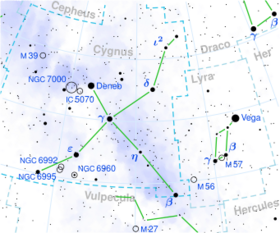Astronomy:Kappa Cygni
| Observation data Equinox J2000.0]] (ICRS) | |
|---|---|
| Constellation | Cygnus |
| Right ascension | 19h 17m 06.16865s[1] |
| Declination | +53° 22′ 06.4534″[1] |
| Apparent magnitude (V) | 3.814[2] |
| Characteristics | |
| Spectral type | G9 III[3] |
| U−B color index | +0.767[2] |
| B−V color index | +0.965[2] |
| Astrometry | |
| Radial velocity (Rv) | –29.3[4] km/s |
| Proper motion (μ) | RA: +60.07[1] mas/yr Dec.: +122.83[1] mas/yr |
| Parallax (π) | 26.27 ± 0.10[1] mas |
| Distance | 124.2 ± 0.5 ly (38.1 ± 0.1 pc) |
| Absolute magnitude (MV) | +0.90[5] |
| Details | |
| Radius | 8–9[6] R☉ |
| Luminosity | 51[5] L☉ |
| Surface gravity (log g) | 2.7[7] cgs |
| Temperature | 4,920[7] K |
| Metallicity [Fe/H] | 0.13 ± 0.07[8] dex |
| Rotational velocity (v sin i) | 3.7[7] km/s |
| Other designations | |
| Database references | |
| SIMBAD | data |
Kappa Cygni, Latinized from κ Cygni, is a star in the northern constellation of Cygnus. It has an apparent visual magnitude of 3.8,[2] which is bright enough to be seen with the naked eye. In the constellation, it forms the tip of Cygnus's left wing.[9] The radiant of the minor Kappa Cygnids meteor shower is located about 5° north of this star.[10]
Examination of this star's spectrum show it to match a stellar classification of G9 III,[3] with the 'III' luminosity class revealing that it has consumed the hydrogen fuel at its core and expanded into the giant star stage of its stellar evolution. It is known to vary in luminosity, but only by about 0.01 to 0.02 magnitudes.[11] The measured angular diameter of this star, after correction for limb darkening, is 2.07 ± 0.09 mas.[12] At an estimated distance of 124.2 light-years (38.1 parsecs) based on parallax measurements,[1] this yields a physical size of about 8–9 times the radius of the Sun.[6] The outer envelope has an effective temperature of 4,920 K,[7] giving it the yellow-orange hue of a star near the transition from a G- to a K-type classification.[13]
References
- ↑ 1.0 1.1 1.2 1.3 1.4 1.5 van Leeuwen, F. (November 2007), "Validation of the new Hipparcos reduction", Astronomy and Astrophysics 474 (2): 653–664, doi:10.1051/0004-6361:20078357, Bibcode: 2007A&A...474..653V
- ↑ 2.0 2.1 2.2 2.3 Jennens, P. A.; Helfer, H. L. (September 1975), "A new photometric metal abundance and luminosity calibration for field G and K giants.", Monthly Notices of the Royal Astronomical Society 172 (3): 667–679, doi:10.1093/mnras/172.3.667, Bibcode: 1975MNRAS.172..667J
- ↑ 3.0 3.1 Morgan, W. W.; Keenan, P. C. (1973), "Spectral Classification", Annual Review of Astronomy and Astrophysics 11: 29–50, doi:10.1146/annurev.aa.11.090173.000333, Bibcode: 1973ARA&A..11...29M
- ↑ Wielen, R. et al. (1999), "Sixth Catalogue of Fundamental Stars (FK6). Part I. Basic fundamental stars with direct solutions", Veröff. Astron. Rechen-Inst. Heidelb (Veröffentlichungen des Astronomisches Rechen-Institut Heidelberg) 35: 1, Bibcode: 1999VeARI..35....1W
- ↑ 5.0 5.1 Anderson, E.; Francis, Ch. (2012), "XHIP: An extended hipparcos compilation", Astronomy Letters 38 (5): 331, doi:10.1134/S1063773712050015, Bibcode: 2012AstL...38..331A.
- ↑ 6.0 6.1 Lang, Kenneth R. (2006), Astrophysical formulae, Astronomy and astrophysics library, 1 (3 ed.), Birkhäuser, ISBN 3-540-29692-1, https://books.google.com/books?id=OvTjLcQ4MCQC&pg=PA41. The radius (R*) is given by:
- ↑ 7.0 7.1 7.2 7.3 Massarotti, Alessandro et al. (January 2008), "Rotational and Radial Velocities for a Sample of 761 HIPPARCOS Giants and the Role of Binarity", The Astronomical Journal 135 (1): 209–231, doi:10.1088/0004-6256/135/1/209, Bibcode: 2008AJ....135..209M
- ↑ Puzeras, E. et al. (October 2010), "High-resolution spectroscopic study of red clump stars in the Galaxy: iron-group elements", Monthly Notices of the Royal Astronomical Society 408 (2): 1225–1232, doi:10.1111/j.1365-2966.2010.17195.x, Bibcode: 2010MNRAS.408.1225P
- ↑ Consolmagno, Guy; Davis, Dan M. (2011), Turn Left at Orion: Hundreds of Night Sky Objects to See in a Home Telescope - and How to Find Them (4th ed.), Cambridge University Press, p. 134, ISBN 978-0-521-15397-3, https://books.google.com/books?id=h3712RgWkOYC&pg=PA134
- ↑ Stegmüller, Wolfgang (1979), The structuralist view of theories: a possible analogue of the Bourbaki programme in physical science, Astronomers' Observing Guides, Springer, p. 82, ISBN 0-387-09460-1, https://books.google.com/books?id=iu9XakR51EsC&pg=PA82
- ↑ Adelman, Saul J. (2001), "On the Photometric Variability of Red Clump Giants", Baltic Astronomy 10 (4): 593–597, doi:10.1515/astro-2001-0404, Bibcode: 2001BaltA..10..593A
- ↑ Richichi, A.; Percheron, I.; Khristoforova, M. (February 2005), "CHARM2: An updated Catalog of High Angular Resolution Measurements", Astronomy and Astrophysics 431 (2): 773–777, doi:10.1051/0004-6361:20042039, Bibcode: 2005A&A...431..773R
- ↑ "The Colour of Stars", Australia Telescope, Outreach and Education (Commonwealth Scientific and Industrial Research Organisation), December 21, 2004, http://outreach.atnf.csiro.au/education/senior/astrophysics/photometry_colour.html, retrieved 2012-01-16
 |


